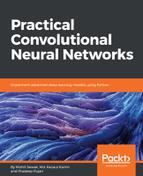CycleGAN is also an image-to-image translator but without input/output pairs. For example, to generate photos from paintings, convert a horse image into a zebra image:

The generator network takes random noise as input and produces a realistic image as output. Running a generator network for different kinds of random noise produces different types of realistic images. The second network, which is known as the discriminator network, is very similar to a regular neural net classifier. This network is trained on real images, although training a GAN is quite different from a supervised training method. In supervised training, each image is labeled first before being shown to the model. For example, if the input is a dog image, we tell the model this is a dog. In case of a generative model, we show the model a lot of images and ask it to make more such similar images from the same probability distribution. Actually, the second discriminator network helps the generator network to achieve this.
The discriminator outputs the probability that the image is real or fake from the generator network. In other words, it tries to assign a probability close to 1 for a real image and a probability close to 0 for fake images. Meanwhile, the generator does the opposite. It is trained to output images that will have a probability close to 1 by the discriminator. Over time, the generator produces more realistic images and fools the discriminator:

